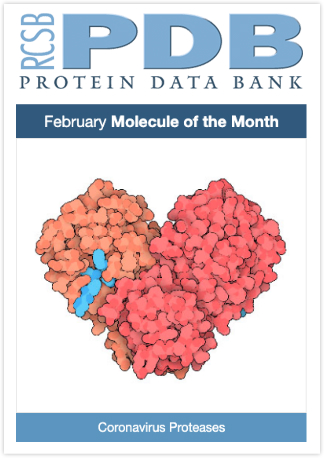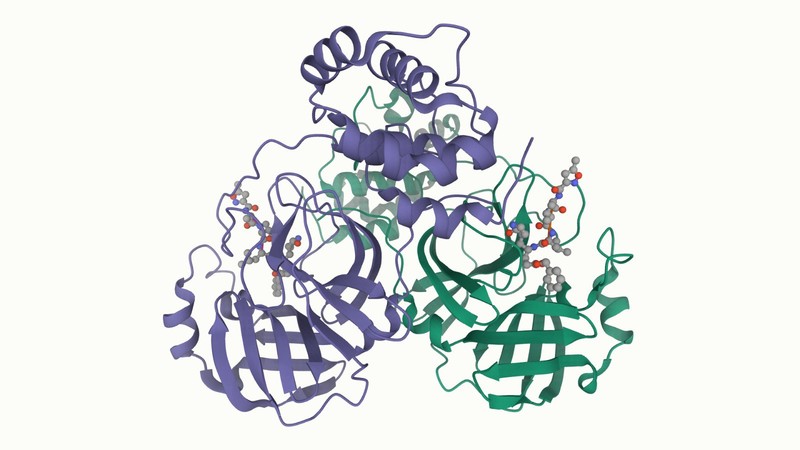近日,上海科技大学免疫化学研究所饶子和/杨海涛团队解析的2019-新型冠状病毒3CL水解酶(Mpro)的高分辨率晶体结构被PDB蛋白质结构数据库(Protein Data Bank, PDB)选为2020年2月的本月明星分子(February Molecule of the Month)。PDB还撰文指出,作为目前唯一已解析的2019-新型冠状病毒的蛋白结构,3CL水解酶(Mpro)结构数据的及时公开,将推进对于新型冠状病毒这一新发现人类病原体的研究及药物发现,有助于科研人员及临床医生应对新型冠状病毒的疫情。

2019-新型冠状病毒3CL水解酶 Mpro晶体结构

PDB 2月明星分子(2019-新型冠状病毒3CL水解酶 Mpro晶体结构)
在新型冠状病毒肺炎疫情出现后,饶子和/杨海涛团队迅速响应,利用多年SARS研究积累的经验,仅用一周时间就解析了2019-新型冠状病毒的最关键蛋白之一——3CL水解酶的高分辨率晶体结构(数据收集在上海光源完成)。2020年1月26日,团队预先公布了2019-新型冠状病毒3CL水解酶(Mpro)的高分辨率晶体结构,晶体结构坐标可到PDB蛋白质结构数据库下载(PDB ID: 6LU7)。
为方便更多的科技工作者第一时间开发以该水解酶为靶点的抗2019-新型冠状病毒药物,在PDB可下载前,饶子和/杨海涛课题组已经为国内外300多家高校、研究机构及公司的实验室直接提供了结构数据。
注:PDB蛋白质数据库是一个开放的生物大分子 (蛋白质、DNA和RNA)结构的数据库,是结构生物学研究的重要资源。作为生物学及医学中第一个开放的数字数据资源,PDB致力于实现科学和生物医学研究与教育的突破,积极拓展基础生物学、生物医学和生物技术的前沿,在全球范围内推动了人类和动物的健康和疾病,植物、食品和能源生产,及其他全球繁荣和可持续性相关领域的高质量研究。
传媒视角
文章来源:PDB 2020/02/04
PDB data provide a starting point for structure-guided drug discovery
A high-resolution crystal structure of 2019-nCoV coronavirus 3CL hydrolase (Mpro) has been determined by Zihe Rao and Haitao Yang's research team at ShanghaiTech University. Rapid public release of this structure of the main protease of the virus (PDB 6lu7) will enable research on this newly-recognized human pathogen.
Recent emergence of the 2019-nCoV coronavirus has resulted in a WHO-declared public health emergency of international concern. Research efforts around the world are working towards establishing a greater understanding of this particular virus and developing treatments and vaccines to prevent further spread.

While PDB entry 6lu7 is currently the only public-domain 3D structure from this specific coronavirus, the PDB contains structures of the corresponding enzyme from other coronaviruses. The 2003 outbreak of the closely-related Severe Acute Respiratory Syndrome-related coronavirus (SARS) led to the first 3D structures, and today there are more than 200 PDB structures of SARS proteins. Structural information from these related proteins could be vital in furthering our understanding of coronaviruses and in discovery and development of new treatments and vaccines to contain the current outbreak.
The coronavirus 3CL hydrolase (Mpro) enzyme, also known as the main protease, is essential for proteolytic maturation of the virus. It is thought to be a promising target for discovery of small-molecule drugs that would inhibit cleavage of the viral polyprotein and prevent spread of the infection.
Comparison of the protein sequence of the 2019-nCoV coronavirus 3CL hydrolase (Mpro) against the PDB archive identified 95 PDB proteins with at least 90% sequence identity. Furthermore, these related protein structures contain approximately 30 distinct small molecule inhibitors, which could guide discovery of new drugs. Of particular significance for drug discovery is the very high amino acid sequence identity (96%) between the 2019-nCoV coronavirus 3CL hydrolase (Mpro) and the SARS virus main protease (PDB 1q2w). Summary data about these closely-related PDB structures are available to help researchers more easily find this information. In addition, the PDB houses 3D structure data for more than 20 unique SARS proteins represented in more than 200 PDB structures, including a second viral protease, the RNA polymerase, the viral spike protein, a viral RNA, and other proteins.
Public release of the 2019-nCoV coronavirus 3CL hydrolase (Mpro) , at a time when this information can prove most vital and valuable, highlights the importance of open and timely availability of scientific data. The wwPDB strives to ensure that 3D biological structure data remain freely accessible for all, while maintaining as comprehensive and accurate an archive as possible. We hope that this new structure, and those from related viruses, will help researchers and clinicians address the 2019-nCoV coronavirus global public health emergency.
文章链接:
https://www.rcsb.org/news?year=2020&article=5e39e03fa5007a04a313edc3



